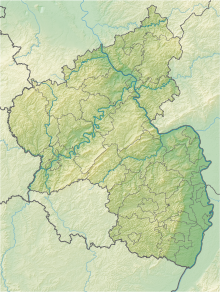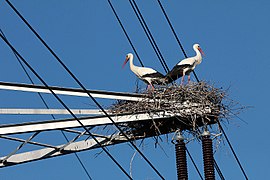Laubenheimer-Bodenheimer Ried
Coordinates: 49 ° 56 ′ 59 ″ N , 8 ° 19 ′ 4 ″ E
The Laubenheimer-Bodenheimer Ried is a Rhineland-Palatinate nature reserve of around 180 hectares today . It is located near the Rhine , in the area of the city of Mainz and the district of Mainz-Bingen . In 1982, 71 hectares were initially designated as a nature reserve. In 1998, the area was expanded to around 180 hectares by means of the Laubenheimer-Bodenheimer Ried extension. The city of Mainz explains the importance of the area: “The Laubenheimer-Bodenheimer Ried is subject to several protection categories, right up to the highest EU protection as an FFH area . They underline the special value and irreplaceability for the animal and plant species living here. "
Area description
The Laubenheimer-Bodenheimer Ried is located in the Bodenheimer Aue in the Upper Rhine lowlands near Mainz. A diverse mosaic of meadow-specific habitats has developed in former clay pits, silted up flood channels of the Rhine and on agricultural areas.
“The protection was given to the rich and endangered bird life in the waters and reed beds. Endangered species such as bluethroat, kingfisher, reed warbler, marsh harrier, spotted marsh grouse and bittern are dependent on these habitats and are sometimes only found nationwide in the Upper Rhine Rift. "
The area's floristic equipment is also of particular importance; more than 630 vascular plant species have been identified. In the flood channels there are very species-rich river valley meadows with numerous peculiarities such as umbel ( Cnidium dubium ), angular leek ( Allium angulosum ), skullcap ( Scutellaria hastifolia ), dyer's notch ( Serratula tinctoria ) and marsh milkweed ( Euphorbia palustris ). The occurrence of numerous halophytes (salt plants), especially along roadsides, is unique in Rhineland-Palatinate.
On the flood dams, Stromtal semi-arid grass grows with mass occurrences of the blue-flowering swamp meadow iris ( Iris spuria ), which can only be found nationwide in Rheinhessen and is most important here.
Protection purpose
Subarea from 1982: Preservation of the wet meadows and reed beds and meadow areas, the semi-arid lawns, the dams and higher-lying areas, the ponds and ditches as significant locations for threatened and rare plant species and plant communities; Preservation of the animal species bound to these habitats, especially animals that cannot adapt to constant human disturbance.
Extension from 1998: Protection purpose is the preservation and restoration of the typical floodplain terrain and site conditions, the preservation and development of extensive grassland on wet to dry, alternately damp and occasionally flooded areas, in particular of river valley, wet and wet meadows, as well as near-natural flow channels and small bodies of water as well of individual succession and extensive arable land.
particularities
Special attractions for visitors are the regularly breeding white storks that build their numerous nests on a power line that runs through the area.
See also
literature
- A. Bitz, H.-J. Dechent: The Bodenheimer Aue between Mainz-Laubenheim and Nackenheim (Rhineland-Palatinate). History, flora and fauna of an endangered landscape . (= Fauna and flora in Rhineland-Palatinate. Supplement 14). 1994, DNB 945001738 .
- R. Kremer, C. Renker: Insights into the mollusc fauna of the NSG “Laubenheimer-Bodenheimer Ried” near Mainz (Mollusca: Gastropoda & Bivalvia). In: Mainz natural science archive. Volume 51, 2014, pp. 237-258.
- S. Liepelt, R. Suck: Species protection project Stromtalwiesen in Rhineland-Palatinate . On behalf of the State Office for Environmental Protection and Trade Inspection Rhineland-Palatinate, Oppenheim 1987. (212 pages)
- S. Liepelt, R. Suck: The river valley meadows and their characteristic species in Rhineland-Palatinate - a protection and care concept. In: Contributions Landespflege Rheinland-Pfalz. Volume 12, 1989, pp. 77-175.
- A. Oesau: Mosses of the nature reserve "Laubenheimer-Bodenheimer Ried" near Mainz (Rhineland-Palatinate). In: Mainz natural science archive. Volume 51, 2014, pp. 221-230.
- L. Simon: Chirocephalus daphanus Prevost - current recovery for Germany (Brachiopoda: Anostraca). In: Fauna and flora in Rhineland-Palatinate. Volume 5, No. 1, 1988, pp. 32-35.
Web links
- Ordinance on the nature reserve "Laubenheimer-Bodenheimer Ried" City of Mainz, District Mainz-Bingen of January 29, 1982 , accessed on April 4, 2018
- Ordinance on the nature reserve "Extension Laubenheimer-Bodenheimer Ried" City of Mainz and District Mainz-Bingen of June 17, 1998, accessed on April 4, 2018
- Laubenheimer-Bodenheimer Ried (map) on protectedplanet.net
Individual evidence
- ↑ State capital Mainz: Laubenheimer-Bodenheimer Ried , accessed on April 4, 2018.
- ↑ State capital Mainz: Laubenheimer-Bodenheimer Ried , accessed on April 4, 2018.
- ↑ Rhineland-Palatinate, Landscape Information System of the Nature Conservation Administration: Profile on FFH area 6015-301 - NSG Laubenheimer-Bodenheimer Ried , accessed on April 4, 2018
- ^ Ordinance on the nature reserve "Laubenheimer-Bodenheimer Ried" City of Mainz, District Mainz-Bingen From January 29, 1982, accessed on April 4, 2018
- ^ Ordinance on the nature reserve "Extension Laubenheimer-Bodenheimer Ried", City of Mainz and District Mainz-Bingen of June 17, 1998, accessed on April 4, 2018
- ^ Storks in the Laubenheimer Ried , accessed on April 19, 2018









